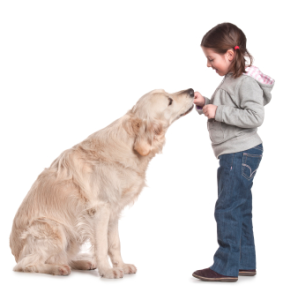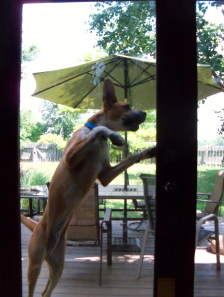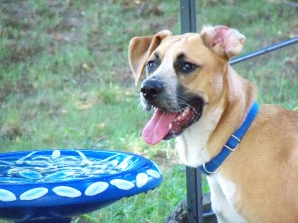 We all know dogs that jump on people, push them out of their way to get through doors, rush their way in and out of the car or the crate and up and down the stairs. Dogs can be impatient and pushy. The smaller they are, the easier it is for owners to accept such energetic outbursts. A 5 lb Chihuahua jumping on us as we walk through the door certainly doesn’t present the same challenges as a 150 lb Great Dane or even a 70 lb Labrador. But regardless of weight, size and strength, there are situations where pushy pooches can put themselves in harms way. Rushing through an open door can lead to disastrous consequences if there’s a busy road nearby. Is this just a temperament trait that we have to put up with? Do dogs eventually calm down and grow out of it or can we effectively teach them alternative behaviors? Controlling our dog’s impulses is in fact quick and easy once we understand how.
We all know dogs that jump on people, push them out of their way to get through doors, rush their way in and out of the car or the crate and up and down the stairs. Dogs can be impatient and pushy. The smaller they are, the easier it is for owners to accept such energetic outbursts. A 5 lb Chihuahua jumping on us as we walk through the door certainly doesn’t present the same challenges as a 150 lb Great Dane or even a 70 lb Labrador. But regardless of weight, size and strength, there are situations where pushy pooches can put themselves in harms way. Rushing through an open door can lead to disastrous consequences if there’s a busy road nearby. Is this just a temperament trait that we have to put up with? Do dogs eventually calm down and grow out of it or can we effectively teach them alternative behaviors? Controlling our dog’s impulses is in fact quick and easy once we understand how.
In humans, impulsivity refers to the urge to act on a whim, with only immediate gratification in mind and little consideration for potential consequences. Impulsivity plays a key role in various disorders, such as ADHD, bipolar disorder or substance abuse disorders, but is also very common in children and adults of all walks of life. We sometimes buy things we don’t need just because we saw them in the store. We indulge in desserts even though we know how unhealthy they are. Research on the subject defines impulsive actions as ‘poorly conceived, prematurely expressed, unduly risky or inappropriate to the situation’ (Evenden, 1999).
Dogs are no different. Their urges to go outside, get out of the crate or get a ball, often override any sense of safety or comfort for both themselves and the humans nearby. Impulsivity can be the result of a reduction of serotonin in the brain (O’Hare 2007, Panksepp, 2012) so when dealing with impulsivity, it’s always a good idea to take measures to increase the levels of serotonin. Food changes are recommended as well as an increase in activity (like walks and playtime). In many cases however, the dogs have simply never been taught polite and appropriate behavior.
Owners find themselves routinely jumped on, shoved to the side and stepped on with little consideration. When a dog wants something, she wants it NOW! But just like we teach our toddlers, who share a similar weakness for giving in to temptations, we can also teach Rex and Sadie that patience, calm and polite behaviors are more effective in getting what they want than jumping, pushing, pawing or barking. For their sake as well as those around them, teaching dogs the art of self-control needs to be, just like it is for children, at the top of our priority list.
 Impulse control, or self-control is useful in almost every situation, from calmly waiting to be hooked on the leash before going out for a walk (instead of jumping around) to patiently sitting for the food bowl, for the ball to be thrown or for the owner’s attention. When applying the following principles in specific situations, the dogs learn patterns and habits that can generalize and help them stay calm and manageable in all situations:
Impulse control, or self-control is useful in almost every situation, from calmly waiting to be hooked on the leash before going out for a walk (instead of jumping around) to patiently sitting for the food bowl, for the ball to be thrown or for the owner’s attention. When applying the following principles in specific situations, the dogs learn patterns and habits that can generalize and help them stay calm and manageable in all situations:
- Identify what it is that the dog wants: that’s the reward. Depending on the situation, the dog may want to go out, your attention, food, a toy or playtime with another dog.
- Whatever the dog does immediately before getting what he/she wants will be rewarded and therefore repeated. If the dog pushes her way out of the door and manages to get out, she’ll learn that pushing her way out gets her what she wants. If jumping up to greet us gets Django’s attention (even when we’re yelling or pushing him off), he’ll do it again next time. The key here is to patiently wait for an alternative behavior, one that we want the dog to repeat. A typical example is hooking the leash to the dog’s collar before going out for a walk. Most dogs get very excited and start jumping up as soon as we grab the leash. Dogs can’t jump forever and if we just stand there and wait, they will calm down. We can also ask the dog to sit and only approach him with the leash when he’s sitting down. If he gets up (which he will at first), we simply take the leash away and wait for him to sit again. It doesn’t take much for the dog to learn that only sitting calmly will get the leash on!
- Practice patience! Staying calm and composed is critical. Frustration and irritation will only contribute to the dog’s excitability and make it harder for him to calm down. We can’t ask the dog to slow down if we’re in a rush for results. Be prepared to spend the time that it takes for the dog to calm down.
- Pick the behavior that you want to reward and wait for it. There is no behavior that the dog will sustain for long periods of time. He can’t jump, bark or paw forever. As soon as the dog performs that behavior, like keeping all four paws on the ground, staying quiet for a few seconds or sitting, reward that behavior by giving the dog what he wants. It will only take a few repetitions for the dog to start offering the alternative behavior instead of the one you’re trying to stop.
- Be consistent! Teaching is effective when we’re consistent. If one day we allow jumping and the next day, because we’re in our work clothes we no longer tolerate it, it’s confusing to the dog and a source of stress. Once we chose to work on a specific behavior, no matter how tired or ready, we need to follow through with the training protocol with the confidence that our efforts will pay off.
- Look for opportunities to teach the dog calm and controlled behavior, such as:
- Asking the dog to sit and wait for your cue before eating his meal;
- Waiting for the dog to sit and wait for your cue before jumping in and out of the car;
- Waiting for the dog to sit and wait for a cue before getting out of the crate;
- When coming home from work, waiting for the dog to have all four paws on the ground before giving her attention;
- Teaching the dog to ‘settle’ on cue.

Django the Boxer mix
Django, a 12 months rescue dog, is a bouncy boxer mix. He was recently surrendered by his previous owners because he was too rambunctious. The short video below illustrates how to teach a dog like Django how to control his urges to jump for what he wants.
Impulse control (or self-control), may be one of the most important concepts to teach any dog. Unfortunately our natural tendencies to deal with impulsiveness often get in the way of effective teaching. When we try to punish the behavior, we often introduce confusion and chaos in the situation, making it harder for the dog to settle down. Instead, simply preventing the dog from getting what he/she wants while out of control and waiting for calm and polite behaviors, will make a world of difference. Dogs become calmer, more focused and easier to control in general. Clarity, patience and persistence are the key elements for success.
Jennifer Cattet, Ph.D.
New game using Pet Tutor(R)
Related articles

New Shell Game by





Fabulous post with loads of useful information. This should be required reading for dog owners.
Thanks – great info. I have been trying to get my friends to do what you demonstrated in the video, to stop my new puppy jumping on them (hold arms in & turn away). So far no one will – they all have their own ideas! Your technique has worked really well with my girl so now I can show my friends what they need to do.
I have a 3yr old Gsd male who really struggles with self control. I have been involved with dogs for over thirty years and this boy is the first one who I have personally struggled with. We do all the correct methods and yet the word wait/stay still is a foreign concept to him. I know his dam’s lines for the last thirty years and he is SO different to this line of breeding, I believe that his problems are from being an only puppy and never having experiencing the buffeting/pushing etc that siblings offer, he didn’t have to compete for milk nor build the tolerances/resistance that puppies teach each other. His mother, and two Aunts were very generous in their behaviour (as bitches do) and tolerated him taking food/toys from them. When we got him as a four month old, he would just rush up to our other 3 dogs and “steal” whatever it
was from them that he wanted at that moment! I have worked hard on that behaviour and now he will wait till the other dog dropped the toy before he will take, though I have to right there and reminding him to “wait”………
He will always be a work in progress and any tips (other than what you have mentioned in this article) would be helpful
Excellent article, Jennifer. Reward-based training you describe always triumphs over punishment-based methods and you obviously support that. The power of a 5-second sit is remarkable.
Another great article. Thanks for your valuable contribution to the dog world!
Hi Jennifer,
I have been reading your blog posts recently. I really like the approach you take on such a sensitive topic as the animals’ training and care, so I feel to be able to trust what you write about, since it shows honesty and yet very good advice.
Being myself a pet owner, I have been working on a web startup that will help animals’ owners provide a better care to their animals and directly communicate with their professional caregivers (vets, trainers, sitters etc).
This post caught my attention and I considered it a good chance to ask if such an idea sounds interesting. If so, I can come back to provide the link of our website (which is at the development stage and we’re working hard to be launched as soon as possible) so that anyone can take a look and hopefully leave a feedback.
Best regards
Manos
Hi Jennifer.
A well thought out and concise approach to an age old problem.
I’m sharing with clients so they can see how easy it is to focus on behaviours they want, rather than allow the dog to practice behaviours they don’t want.
I thought your followers might also like to read my latest self control blog here:
http://www.dogstardaily.com/blogs/sue-mccabe/%E2%80%98i-want-i-want%E2%80%99-or-%E2%80%98please-may-i%E2%80%99
Regards,
Sue McCabe
http://www.muttamorphosis.co.uk
apdt UK no. 00956
Kennel Club Listed Status
This is great advice… I will start immediately with my two. Thank you!
Well done! Will share with others.
i would love to know what you suggest for a dog running at the fence trying to get at a deer on the other side as i have deer always coming into my yard we cant even go for a walk with out seeing deer i find i am struggling with this
Just wanted to thank you for this clear description and video. I teach pet obedience classes and will be regularly sending students to this link for reading/watching. You say it better than I ever could!
A nice reference on teaching calmness on the mat… http://www.dogwise.com/ItemDetails.cfm?ID=DTB1301
Getting a 6 month old pit who has been trained but yet is aggressive at my dad who had a stroke an cant correct his behavior. ?
Thank-you!!!! This is how I work with dogs, what I tell my clients and have had amazing success.
hi there i am looking for some training tips for my 18 mon. old lab specifically with having her stay calm when confronting a dog on our walks on our own she is quite good minimal pulling and for the most part walks on my left at or behind me slightly however when she senses a dog in the vicinity her urge to go and play over comes her calm demeanor and will pull to go and play with that dog she is not aggressive at all but i would prefer to have her meet dogs in a calm fashion and on my terms please help thankyou Glen Brown
I need help with my dog. He waits for his food, he waits before he’s allowed to go up or down the stairs or leave his cage or leave a room but as soon as I say “okay” he RUNS down the stairs/through the room/jumps up from his sitting position and quickly pushes himself to his food bowl. It’s not a calm behavior that he is showing, he is being obedient but not calm. He gets overly excited when I tell him he can go and he’s hurt me and my husband several times (I’m now pregnant) by pushing us or jumping through our legs to get by us. Please any advice will help thank you
My dog chases my feet, especially wearing slippers. He bites. How do I remain calm?